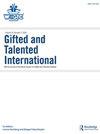Where do eminence and transformational achievement fit into the gifted education picture?
Q3 Social Sciences
引用次数: 0
Abstract
This special double issue tackles a question, one among many in our wonderfully complicated field, that is philosophically charged and very much associated with the relationship of high performance to giftedness. The authors of the articles in this special issue do not conflate eminence with fame, which can be derived by outstanding contributions but also simply by being outrageous. Eminence is promoted here as a hard-earned designation given by peers for contributing to the betterment of practice, human well-being, or the promulgation of new ideas within a field. As eminence is very rare in the school age population, and generally is acknowledged much later in individuals’ lives, it is often left out of discussions about gifted education. The editors and authors of this special issue would argue that talent development is a lifelong journey, one that is often punctuated by important school experiences, but also takes place outside of schools, at home, and in communities of support. We feature nine articles in this special issue according to the following categorizations. First, we present articles that are framed around a model of talent development from potential to eminence or transformational achievement. Worrell and colleagues discuss the concept of eminence as the goal of talent development, an aspired endpoint of their Talent Development Megamodel, with the understanding that not all of those who are talented in earlier developmental periods will have the wherewithal, commitment, or psychological strength to pursue a creative product that changes the status quo in a domain. The article offers examples of trajectories from potential to achievement to expertise, and for some individuals to eminence in various domains. Paik and her colleagues present a biographical analysis of 19 and 20 century artists from minoritized groups framed by their Productive Giftedness Model. The model’s trajectory is also from potential to eminence. The focus of the model is on external factors such as the support derived by peers, families, mentors, and teachers, which were particularly salient for the individuals studied given the constraints and obstacles they encountered because of their gender or race. We are introduced by Balestrini and Stoeger to an example of what might be called an outlier talent field – Drum Corps. These fields have not been traditionally studied by researchers but offer interesting avenues to apply theoretical perspectives and gain new understandings about talent development. The drum corps phenomenon is framed using the Actiotope model, which focuses on the systems that support talent development in different domains. Unlike the other talents studied in the special issue, drum corps involves brilliant performance in unison with others. Two articles are focused on models as applied to eminent women. One, by Reis and Holinger, employs Reis’ female talent development model to study women with outstanding accomplishments in diverse fields. This article highlights the intentional approaches taken by the women to push boundaries in their fields in the pursuit of creative productivity. The article discusses the personality characteristics and environmental supports that promote strategic risk taking, particularly for women. Kronborg’s article highlights two components of her feminist model for developing talent: passionate engagement and taking opportunities. She does this by providing deep biographical exploration of several contemporary eminent Australian women and proposing that these two internal facGIFTED AND TALENTED INTERNATIONAL 2021, VOL. 36, NOS. 1–2, 1–2 https://doi.org/10.1080/15332276.2022.2051970卓越和转型成就在天才教育中的地位在哪里?
这期特刊解决了一个问题,这是我们这个极其复杂的领域中的众多问题之一,这个问题充满了哲学色彩,与高绩效与天赋的关系密切相关。本期特刊文章的作者并没有将卓越与名声混为一谈,名声既可以源于杰出的贡献,也可以源于令人愤慨。卓越在这里被提升为同行们来之不易的称号,因为他们为改善实践、人类福祉或在一个领域内传播新思想做出了贡献。由于卓越在学龄人群中非常罕见,而且在个人生活的后期也得到了普遍认可,因此它经常被排除在关于天才教育的讨论之外。这期特刊的编辑和作者认为,人才培养是一段终生的旅程,经常会被重要的学校经历打断,但也会发生在校外、家里和支持社区。本期特刊共有九篇文章,分类如下。首先,我们提出的文章围绕着一个从潜力到卓越或转型成就的人才发展模式。Worrell和他的同事们讨论了卓越作为人才发展目标的概念,这是他们人才发展大模型的一个理想终点,他们明白,并非所有在早期发展时期有才华的人都有财力、承诺或心理力量来追求改变一个领域现状的创造性产品。这篇文章提供了从潜力到成就再到专业知识的轨迹,以及一些人在各个领域脱颖而出的例子。白和她的同事们对19世纪和20世纪来自少数族裔群体的艺术家进行了传记分析,并以他们的生产天才模型为框架。该模型的发展轨迹也是从潜力到卓越。该模型的重点是外部因素,如同伴、家庭、导师和教师的支持,考虑到受试者因性别或种族而遇到的限制和障碍,这些因素对受试者来说尤为突出。Balestrini和Stoeger向我们介绍了一个可以被称为异类人才领域的例子——Drum Corps。这些领域传统上没有被研究人员研究过,但为应用理论视角和获得对人才发展的新理解提供了有趣的途径。鼓队现象是使用Actiotope模型构建的,该模型侧重于支持不同领域人才发展的系统。与特刊中研究的其他天才不同,鼓队需要与其他人一起进行精彩的表演。有两篇文章的重点是适用于杰出妇女的模式。Reis和Holinger的一项研究采用了Reis的女性人才发展模式,研究在不同领域取得杰出成就的女性。这篇文章强调了女性在追求创造性生产力的过程中,有意突破自己领域的界限。文章讨论了促进战略风险承担的个性特征和环境支持,特别是对女性而言。克伦伯格的文章强调了她培养人才的女权主义模式的两个组成部分:热情参与和抓住机会。为此,她对几位当代杰出的澳大利亚女性进行了深入的传记探索,并建议这两位内部专家和天才国际2021,第36卷,编号1-2,1-2https://doi.org/10.1080/15332276.2022.2051970
本文章由计算机程序翻译,如有差异,请以英文原文为准。
求助全文
约1分钟内获得全文
求助全文

 求助内容:
求助内容: 应助结果提醒方式:
应助结果提醒方式:


